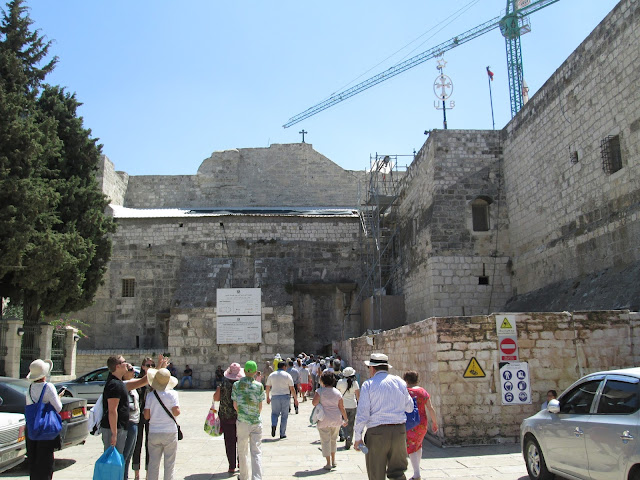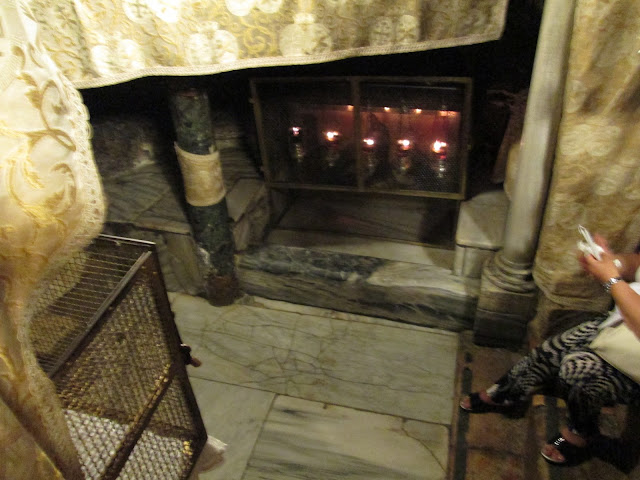Okay, so Bethlehem isn't exactly little anymore, at least not by its original standards; compared to Jerusalem and Tel Aviv it is still quite small (it boasts a population of approximately 25,000). Bethlehem is actually a Palestinian city, located in the West Bank.
First stop was at the Milk Grotto Church (yes, I know this is a kind of strange name). Tradition says that the Holy Family (Mary, Joseph, and Jesus) took refuge here during the slaughter of children ordered by Herod, before their flight to Egypt. While in this church Mary was nursing Jesus, and tradition says a drop of milk fell to the ground turning it white. Many believe that powder from the milk white rock has magical powers, such as enhancing fertility especially in infertile couples as well as boosting the quantities of milk in nursing mothers. It is also 'home' to 12 nuns who have devoted themselves to a life of prayer. They pray 24 hours a day, every day of the year (obviously in shifts). Visitors are welcome to leave prayer requests, and the nuns will pray for them.
 |
| Statue of Mary nursing Jesus |
 |
| Mary, Joseph, Jesus inside the caves of the church |
 |
| One of the nuns praying |
On the outskirts of the Shepherds Fields there is an excavation in the works of an old Byzantine church/monastery.
 |
| some of the excavations--the covered area is an old olive press |
 |
| On a side note.....the Shepherd's Field church has a really neat dome ceiling |
The last stop of the day was at the Church of the Nativity. The Church of the Nativity is actually home to three different churches....an Armenian Church, a Greek Orthodox Church, and a Catholic Church. The church was originally commissioned by Constantine and his mother Helena to be over the site (a cave) that is traditionally considered to be the birthplace of Jesus.
 |
| Church of the Nativity--doesn't look like anything special does it, kind of ironic when you think about it |
The Door of Humility is a small entrance into the church. It was created in Ottoman times to prevent carts being driven in by looters, and to force all visitors to dismount from their horses before entering the holy place.
 |
| Door of Humility |
Anyway, beneath the Church of the Nativity, there is rectangular cavern that is honored as the site of Christ's birth (since at least the 2nd century). There is a small area that is where the manger most likely would have been, and there is a silver star on the floor that marks the spot where Christ is believed to have been born. On a side note, above the silver star there are 15 lamps hanging (six belong to the Greeks, 5 to the Armenians, and 4 to the Latins).
Let me say it was a very emotional moment for me to reach down on the ground and touch the star. Whether it is the 'actual' birthplace or not, what it represents is astounding--the birth of Jesus, who changed the course of the entire world history.
 |
| the outer cave |
 |
| the manger area |
The star has 14 points on it, and has become known as the Star of Bethlehem. These represent the 14 generations of Jesus Christ. There are 14 years from Abraham to David, 14 years from David to the Babylonian captivity, and another 14 years from the Babylonian captivity to Jesus Christ. The 14 points are also believed to represent the 14 stations of the cross.
I can say that this was a very emotional day to be seeing these places and to be walking along the same places where so much history happened......and to really have such a grasp the reality of it all when it is right in front of you.
I am going to post a few more pictures of the sites of the day...........
Armenian Church--it is mostly under restoration and you are unable to see anything, but they do have the original floors of the church uncovered so visitors can see the mosaic tile floors.

Greek Orthodox Church--surrounded by lots of scaffolding due to the restoration project

 |
| Sign inside the Church of the Nativity |
 |
Looking out over Bethlehem
|
 |
Security wall between Israel and the West Bank |




















No comments:
Post a Comment